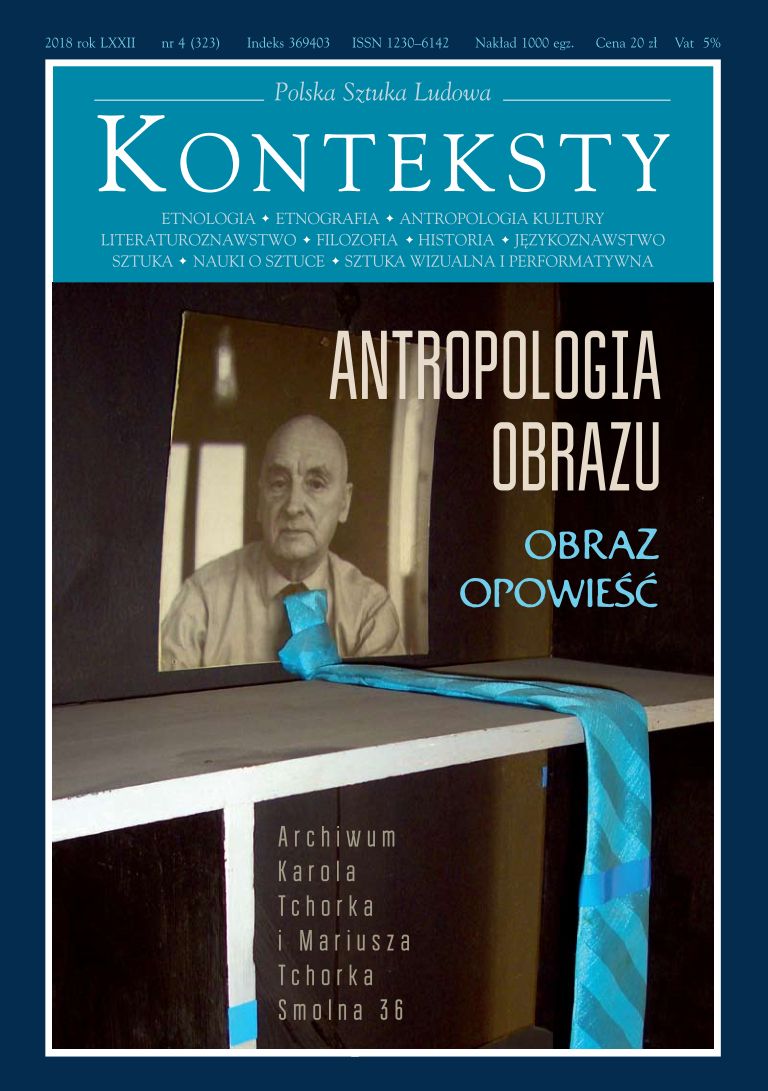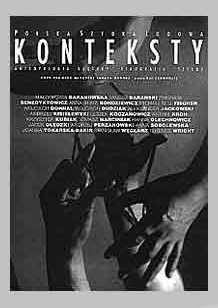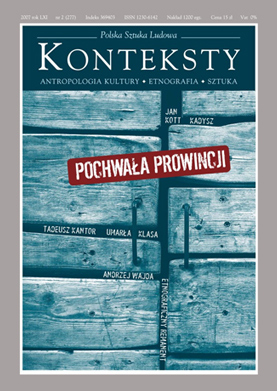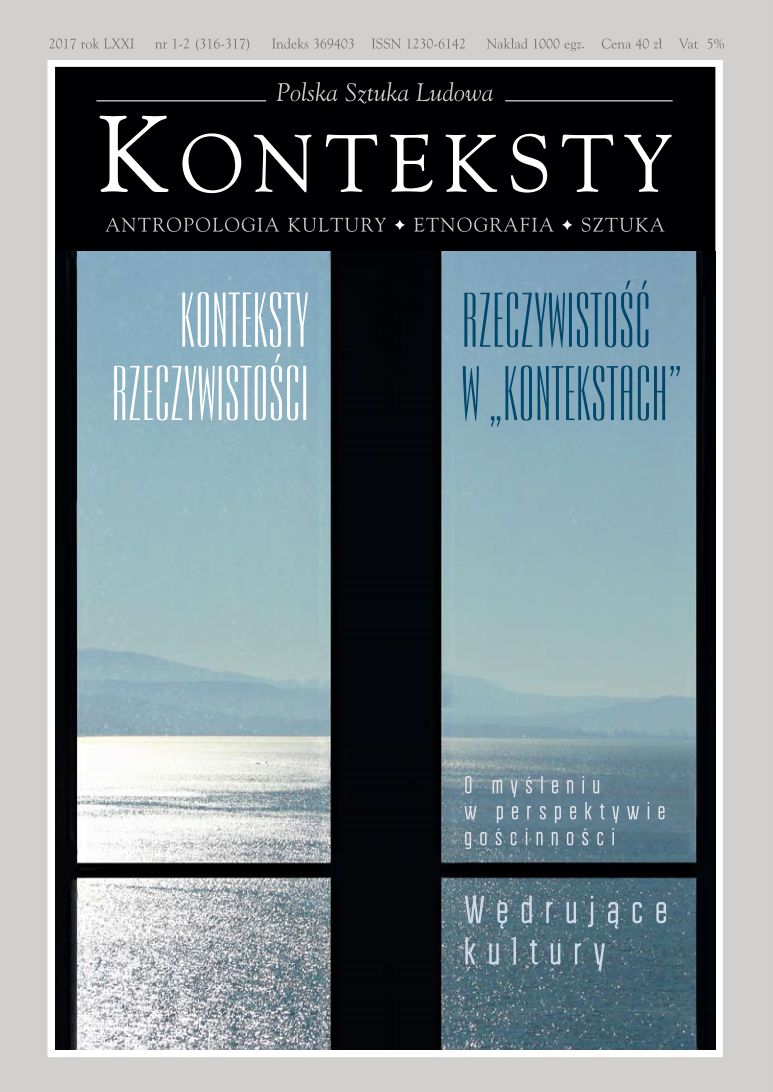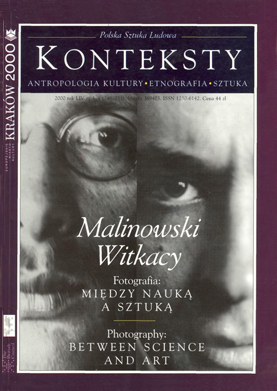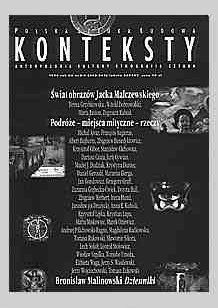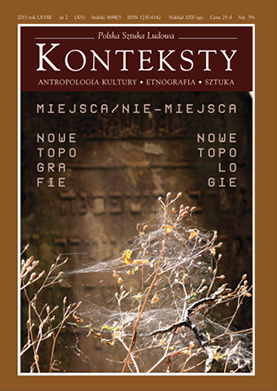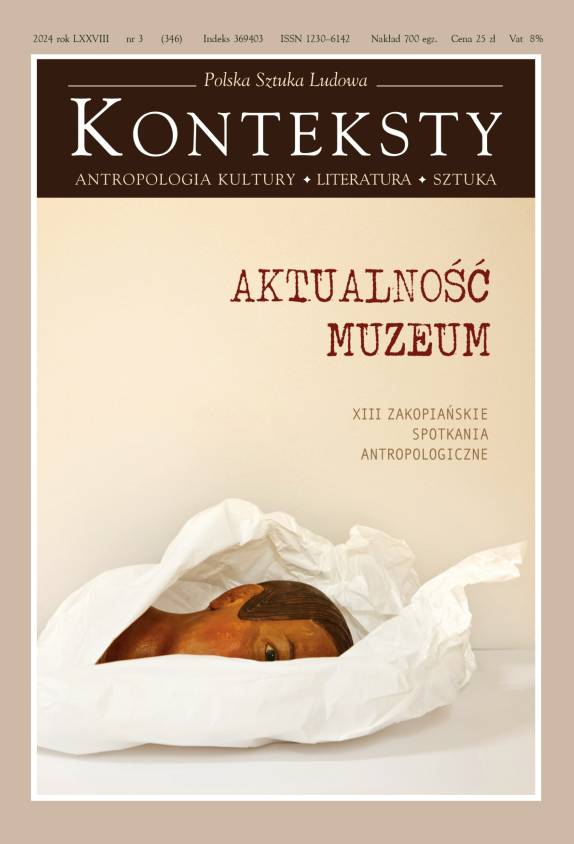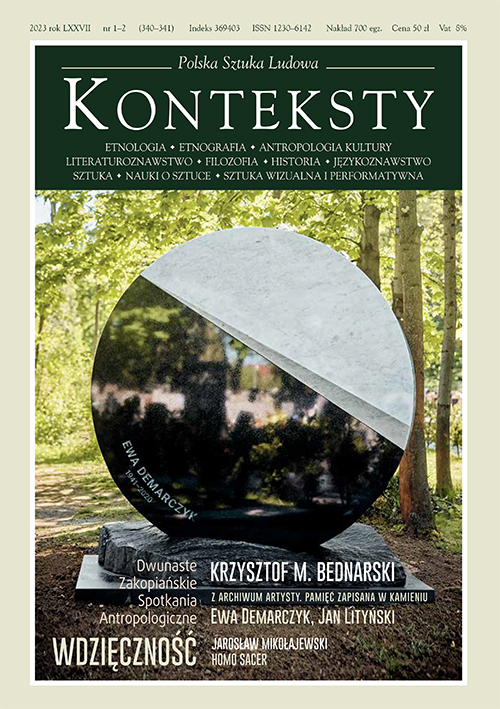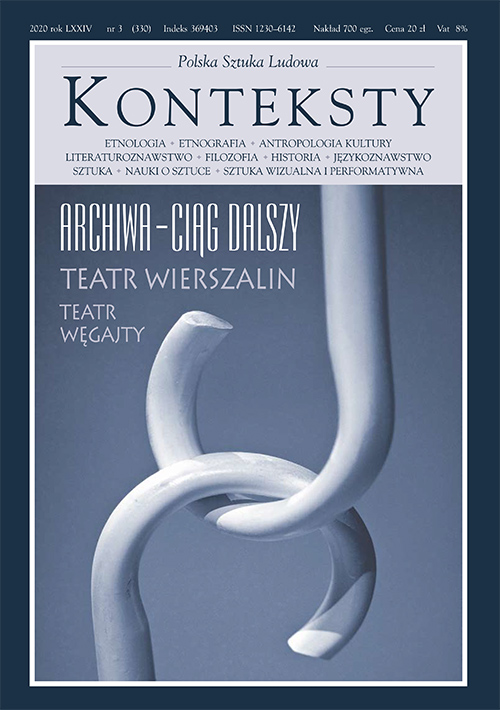Issue 2003/1-2 (260-261) - -

| Wiktor Zborowski | 5 | |
| Hanna Faryna-Paszkiewicz | To Be as Rich as Forsythe  | 6 |
Piotr Paszkiewicz, an outstanding historian of art, translator and, as his wife - the author of the text - adds, a passionate traveller, died on 8 July 2002. In a note discovered on his desk he wrote: “Voyages are the very essence of my life and a source of renewed strength. I am fond of distant and near destinations, the latter signifying Europe and the former... I have in mind both private and professional trips. I have probably grown less interested in of sightseeing and have become more enthralled by magnificent landscapes and the view of the sun setting and rising above a beautiful sea than by historical monuments”. | ||
| Zbigniew Benedyktowicz | 14 | |
| Dariusz Czaja | 18 | |
| Maria Poprzęcka | The Image Concealed by Our Eyelids  | 20 |
An examination of the fallacy of seeing and memory, encountered in his practice by the historian of art. The revealed doubts prove to be close to the reservations addressed to the history of art in its capacity as a science. The skeptical vision of the abilities of the discipline are supplemented by additional apprehension concerning the trust placed in the certainty of the "eye" and "undisturbed perception" of the historian of art, i. e. two elementary factors comprising the object and subject of the discipline. | ||
| Julia Hartwig | 32 | |
| Julia Hartwig | 33 | |
| Georges Steiner | Grammars of Creativity  | 34 |
A fragment of the third chapter of a book by George Steiner, in which the author discusses the puzzle of creation. What does it mean to create? What is the possibility of true creativity in a situation in which every human construction is the outcome of a recombination of already existing elements? G. Steiner devoted particular attention to the language of verbal creativity, underlining the fact that language is its own memory, enrooted in a cumulative past and a multi-aspect future. We incessantly construct innumerable variations of ready-made themes already present in the existing language. Originality, therefore, appears to consist of a return to the sources, aptly confirmed by the similarity of originality and origins. | ||
| *** | ||
| Paul Ricoeur | The Abuses of Natural Memory: Restrained Memory, Manipulated Memory, Imposed Memory  | 41 |
Fragment of a book by the celebrated French philosopher Paul Ricoeur. The author's point of departure is composed of Freud's ascertainments concerning the pathology of memory; subsequently, this problem, formulated in the language of psychoanalysis, was transferred to the domain of existential experience. The "abuses of memory" (and the "abuses of oblivion") are observed within the critique of ideology by discussing steered forms of the manipulation or instrumentalisation of memory. From a normative vantage point the author also examined the "obligation of memory". This is a "journey among the figures of the uses and abuses of memory, from restrained memory via manipulated memory towards imposed memory". | ||
| Yosef Hayim Yerushalmi | Biblical and Rabbinic Foundations. Meaning in History, Memory and the Writing of History  | 55 |
A translation of the first chapter of Zakhor. Jewish History and Jewish Memory, in which Y. H. Yerushalmi considered two current paradoxes of Judaism. The first pertains to a fundamental issue: why did Judaism, a religion which places strong accent on the historical aspect of divine revelation and is permeated with an awareness of history, attach such an insignificant rank to historiography in the Western understanding of the term? The second paradox encompasses an equally important problem: considering that the identity of the Jewish nation was based on memory why did historians eschew its recording and cultivation? The author underlines the fact that Jewish memory concerned primarily that which was worthy of remembrance for Biblical mentality: divine intervention in human history and man's response. Historiography, conceived as the registration of current facts, was thought to be meaningless. For post-Biblical rabbinic interpretation historiography signified consent to the acceptance of the motives of thinking present in the Bible, which possessed the power of revealing the holistic plan of history. | ||
| Ivan G. Marcus | Magic, Food and Mnemonic Gestures  | 68 |
A chapter from the book entitled Rituals of Childhood. Jewish Acculturation in Mediaeval Europe , whose author discussed in depth the techniques of remembering Biblical texts of significance in child pedagogy. Magical and mnemonic functions were ascribed to such activity as licking honey off the alphabet written on tablets, eating words and letters inscribed on hard boiled eggs, or reciting spells used to deter Potah, the prince of forgetfulness. During the Middle Ages, such practices belonged to widely applied rituals of the initiation which moulded Jewish identity. | ||
| Małgorzata Nałęcka | Cursed Blessing  | 83 |
Which is better from the ethical viewpoint: memory which condemns to eternal suffering or which ends in a cruel, bestially inflicted death? Or is oblivion, thanks to which our being avoids a pitiful end, better than finding out just how evil the world is? The presented essay is an attempt at viewing oblivion via a reverted paradigm. A brief analysis of the contents of the verb "to forget" is followed by a discussion of the good and useful aspect of oblivion/forgetting upon the basis of Loyal Ruslan by Gieorgiy Vladimov and The Prosecutor of Judea and Other Tales by Varlam Shalamov; the heart of the matter concerns a recognition of the salutary value of a certain variety of individual oblivion which protects us against the self-inflicted suffering of memory. | ||
| Bohdan Kos | Memory and Time-space in a Search for a Whole. Several Remarks about the Renaissance Theatre of Memory and the Charms of Cosmology  | 88 |
The author queries the customary beliefs which link memory predominantly with the category of time. By recalling the Renaissance art of mnemonics (memory theatres and palace) he demonstrates the close connection between memory and physical space. Remarkably, the author also of the past, a collection of ancient documents, and a powerful archive containing memory about the origins of the universe. | ||
| Wojciech Michera | Obliviscere. On the Temptation of Oblivion and the Dilemmas of Representation  | 90 |
Memento, the film by Christopher Nolan, is not only a radical criticism of "writing" conceived as (mnemo) technology, which by relegating "living memory" appears to render reality virtual (in the manner of a computer programme in Matrix), but also an illustration of the eternal temptation of oblivion. The author of the article regards film as a special illustration of the philosophical-anthropological dispute concerning the value of memory, envisaged as a cognitive obstacle or source. He compares the phenomenological approach (in which the source of cognitive obviousness is perception, and memory is an obstacle) and the view expounded by Jacques Derrida for whom memory, also materialised in a written form or an image, is an indispensable and primeval "always already" existing cognitive context. | ||
| Jacek Zlemek | Memento. Do You Remember This? Then Look  | 98 |
The intention of this text was to delineate a wider horizon of the pragmatic of the reception of Memento, a film by Christopher Nolan. The author ponders the consequences of the appearance of a motion picture which openly perceives the theme of the post-projection memory of the audience and equally openly manipulates with data transmitted in the course of the viewing. The text resorts to the fundamental premises of cognitivism (as a method) and internet discussions involving members of the audience (as raw material). A critical presentation of the assorted models of interpreting the film, proposed by a group of spectators, and the method of reconstructing the plot. | ||
| Ruth Gruber | Cities without Jews  | 105 |
Over the past couple of decades, and particularly since the fall of communism in 1989/1990, Europe has seen the growth of a phenomenon whereby the “Jewish phenomenon” - anything to do with Judaism, Jews, Jewish culture, the Holocaust and Israel - has been increasingly recognized as part of national history and culture and embraced by the mainstreams. As part of this trend, Jewish culture - or what is perceived or defined as Jewish culture - has become a visible component of the popular public domain in countries where Jews themselves now are practically invisible. This is a Europe-wide phenomenon, observable in countries whose people were the perpetrators as well as the victims and bystanders of World War II and the Holocaust, in countries that straddle the one-time Iron Curtain, in countries where anti-Semitism is also still alive and sometimes openly voiced. In the points to a similar union by referring to contemporary cosmological intuition. From this vantage point, space is conceived as a storehouse1990s, Paris-based historian Diana Pinto coined the term ,Jewish Space" to describe the place occupied by Jews, Jewish culture and Jewish memory within mainstream European society - a place that is universal and exists regardless of the current size or activity of the local Jewish population. Europeans have “filled” this Jewish space with a “virtual Jewish world” that often dwarfs Jewish communal presence. For some, the process has been a way of filling in the blanks of a communist-era agenda that long made Jewish issues taboo. For others, it is a means of coming to terms with the Nazi legacy or a key to building (or rebuilding) a democratic and tolerant state. Motivations range from serious scholarly pursuit to the crass quest for a quick buck. The process is filled with ambiguities and some of the elements are disturbing, such as the tendency to regard Jews, at times, as cherished museum objects rather than as living, vital entities. The history and memory that are resurrected are often distorted or codified to suit specific local and personal needs. They must coexist with present and past realities, and sometimes do so uneasily. Sincere attempts to reintegrate what has been lost, destroyed or forgotten coexist with superficiality, slogans and show. Nostalgia, stereotypes and commemoration can become shorthand tools in the creation of what often “absolute fake” environments; “where the boundaries of game and illusion are blurred” and where “absolute unreality is offered as a real presence.” But there is much, too, to applaud. A dozen years ago it would have been difficult to imagine that Jewish culture would have such a prominent and popular place in the European mainstream. And for the first time, Europeans, and European countries, are recognizing Jewish culture, Jewish history and the Holocaust itself as part of their own narrative and not a separate “Jewish thing.” | ||
| *** | ||
| Marcin Świetlicki | 117 | |
| Anna Bolecka | Memory and Childhood  | 118 |
Memory is composed of remembering and forgetting, which comprise the condition of our development and delineate the rhythm of life. Both phenomena, albeit ostensibly contradictory, possess a single source - time. Memory attaches prime importance to the past, predominantly to childhood. Upon certain occasions, our memory constitutes a receptacle of sorts, used for preserving the past. From such a "memory tin" we may extract everything which has not been deformed by the processes of remembering and forgetting. The mechanisms of time and memory may conceal sources of artistic creativity. The man of letters ascribes significance also to mythical memory, a mixture of the real and the imaginary, the individual and the shared. Mythical memory is a living fount and an answer to our profound need to halt the passage of time. | ||
| Antoni Kroh | The Old River Valley . The Brass Cross, A Dog Called Puk, Typewriters  | 121 |
Three successive pictures from the past (in "Konteksty" 3-4 2002 we published another fragment of the book prepared by the author). A. Kroh refers to his private memory, at the same time showing how History incessantly intertwines with the unique fate of an individual. | ||
| Amelia Franas | Execution of Memory  | 129 |
An attempted description and interpretation of Executions of Precious Recollections, a multi-media spectacle staged by Blixa Bargeld. The point of departure of the show was a questionnaire composed of fifty questions devised by Bargeld himself and concerning ways of restoring the private past and important "places" in individual memory (e. g. remembered colours, flavours and aromas). While answering the Bargeld questionnaire, the author became, due to an unexpected twist of fate, one of the heroines of his spectacle (or, more exactly, its Polish version). In her capacity as the "author" of part of the scenario, she turned into a subject of the production, while as a spectator she acted as its object. This double role, which recalls — toute proportion gardée - the experiences of Kirsten Hastrup, is the theme of anthropological reflection. | ||
| Joanna Zdanowska | Bargeld`s Couch, or On the Manner of Describing a Spectator  | 133 |
An attempted reflection dealing with the dynamics of human memory, inspired by a spectacle featured by Blixa Bargeld at the Stary Theatre in Cracow (November 2001). The widest possible framework for the deliberations is offered by Paul Ricoeur's conception of narrative identity, the outcome of research into the memory of witnesses, conducted by Elizabeth Loftus, and the premises of Freud's classical psychoanalysis. The prime thesis of the text pertains to the astounding flexibility of individual memory and the possibility of its considerable modification with the assistance of assorted suggestion techniques, including suitable artistic impact (in this particular case: a theatrical spectacle). The article is composed of two intertwining motifs: psychological data are referred to a concrete staging, and theoretical reflection is illustrated by a description of the relevant reaction (impression) of the spectator. Finally, J. Zdanowska took into consideration the declarations of the author of the play concerning the aim of the project and the manner of its realisation. | ||
| Stefanie Peter | Kogel Mogel as the "Polish Madeleine"? The Destroyer-Romanticist Blixa Bargeld Recollects Poland  | 137 |
A journalistic account, written by an anthropologist, about Executions of Memory, the spectacle given by the German performer Blixa Bargeld in Cracow. This view "from the outside" deals with the manner in which Poles construct the memory of their childhood. | ||
| Gerdien Verschoor | Whiskers — Polish Reminiscences  | 139 |
During the 1990s the author, a Dutch historian of art, lived in Poland where she received her Ph. D. degree in the Institute of Art at the Polish Academy of Sciences and fulfilled the function of the cultural attaché at the Dutch Embassy. This collage of brief recollections is a record of private impressions of Polish reality. | ||
| Jan Gondowicz | Memory Palace  | 146 |
A single episode from Madame Bovary by Gustave Flaubert - a description of the ball given by Marquis Vaubyessard - discloses the structure of a description subjugated, probably unconsciously, to the rules of the functioning of memory. Numerous reminiscences in Flaubert's novel indicate the biographical and even traumatic foundation of this episode. This deviation from strict realism is perceived by the author of the essay as a foretaste of literary techniques typical of the twentieth century, and given the collective name of magical realism. The source of such practices should be regarded as tantamount with the introduction of the subconscious memory. | ||
| *** | ||
| Lew Łosiew | Josif Brodski`s Venice  | 149 |
The author of this text on the image of Venice in the works of Josif Brodski meticulously analysed all those fragments which refer to Venice — the symbolic motifs (water, mirror) in the poetic tale of the city. In an extremely valuable approach he placed Brodski's Venice against the backdrop of Russian nineteenth — and twentieth-century literature, allowing the reader to become aware of the originality and poetic novelty of this particular perception of Venice. | ||
| Wojciech Bońkowski | Twelve Pigs Examine Their Reflection in a Mirror. On the Venetian Legend  | 156 |
Venice, a unique town, is also inimitable due to the manner in which she has created her own legend while competing with other mediaeval city-states not only militarily and economically but also at the level of the image and myth. The author shows the process in which religion as an institutionalised element of the life of the republic, subjected to its secular authorities, became an important factor in the construction of the identity of the commune. A town gained holiness if it was built upon the physical relics of its holy patrons. Deprived of an ancient lineage, seeking prestigious patronage, and facing the necessity of building a myth which would overshadow the rival myths of other Italian towns, in 828 Venice, or rather its citizens, stole the body of St. Mark the Evangelist from the tomb in Alexandria; soon, work was inaugurated on the construction of a basilica, completed in 1094 - This was not enough - Venice went on to devise a myth of her foundation, based on a legend about the two Aquileiae - on land and Venice, located on a lagoon created in 421 when the former was razed by Attila, the Scourge of God. The cause was conveyed onto the Hun ruler, the executor of a divine plan, and the town was placed among the foremost defenders of Christianity. The next element in the creation of the legend was the granting of a teleological meaning to the existence of the original Aquileia — a Chronicon compiled in 1081-1208 mentions the foundation of the town by fugitives from Troy. The following myth-creating element pertains the transference of the town to the region of the lagoon - the chronicle by Martin de Canal (1267-1275) notes that Venice was established en Van de incarnation de nostre seignor Jesu Crist, on the day of the Annunciation. Thus, its existence becomes a fragment of a divine plan of the redemption of mankind. Now to explain why the doge and not a Church supervisor of the republic became the depository of the relics of St. Mark. The translatio of the body served the salvation of Christianity since the Alexandrian tomb of the Evangelist was threatened by Egyptian Moslems. There emerges the motif of the dream of Mark, central for the whole myth, in which the Evangelist, while travelling to Aquileia, saw an angel predicting the future. The Venetian epos of St. Mark contains all the anthropological myth-creative elements - praedestinatio at the basis, as well as passio, inventio and translatio; the latter two occur in reverse order (the passio of St. Mark is followed by the translatio of his relics, but inventio took place after the redesigning of the basilica, when the body was found). Venice also constructed her own myth of independence vis à vis all secular authorities as evidenced by the act of bestowing ducal insignia upon the doge, performed by Pope Alexander III in 1152; this myth is to be served by celebrations of anniversaries of the victory over Aquileia (1162) and a carnival whose culmination is the Thursday prior to Quinquagesima Sunday, entailing the slaughter of pigs - the annual contribution made by Aquileia. The fundamental components of the republican myth of Venice include liberty, independence and piety; the existence of the town is associated with the supra-temporal mythical sphere by means of causal-effective ties. Imaginary facts are remembered and celebrated, and everything, including memory and commemorations, is subjected to myth-creative activity: memory precedes and creates events. | ||
| Dariusz Czaja | On the Way to Venice. Imaginary Journeys  | 161 |
Can one be in Venice without actually staying there? The author convinces us that this feat is possible. Upon a basis of three literary texts (a story by Włodzimierz Odojewski, an essay by Harry Matthews and Georges Perec, and a novel by Italo Calvino), he followed closely the rhetorical mechanisms of constructing an image of Venice. In conclusion, he pondered on the cognitive status of those tales and asked about the potential meaning of the expression: "I really was in Venice", thus doubting the truth of eye-witness realism. | ||
| Ewa Malec | The Myth of Venice. The Production of Memory  | 174 |
A brief outline of the history of the manner in which mediaeval Venice constructed its own myth, based on three towns-models: Rome, Constantinople and Jerusalem. Thanks to the joint efforts of historiographers, artists and doges, Venice managed not only to create a synthesis of those three holy cities and to win pride of place in Italy, but primarily was capable of establishing an urban past worthy of its splendour. Chronicles thus described the divine origin and ancient lineage of the town, multiple churches erected in the Byzantine style featured newly-obtained valuable relics, pilgrims to the Holy Land were welcomed, and numerous statues, columns and mosaics were brought over from Constantinople. The ensuing effect exceeded the most audacious expectations and became the foundation for a later, entirely different myth of Venice - the town of death and illusion depicted in literature. | ||
| Bohdan Kos | 181 | |
| Piotr Kłoczowski, Małgorzata Dziewulska | A Remembered Conversation: I Would Not Like to Say Too Much  | 183 |
In a dialogue with Małgorzata Dziewulska Piotr Kłoczowski shares his visual recollections about writers and artists from the milieu of the Parisian "Kultura", i.a. Kot Jeleński, Czapski and Lebenstein as well as reflections about people who opted for the status "of modest life and indifference towards all the goods of this world" in order to protect themselves in the ruptured postwar world against becoming uprooted, and to preserve inner freedom. | ||
| Julian Tuwim | 193 | |
| Hanna Baltyn | Drawerlandia  | 194 |
A large fragment of non-fiction, a book belonging to a current which may be described as "household anthropology" - the author resorted to a description of the contents of drawers and home collections of assorted objects or works of art in an attempt to determine the factors which mould the awareness of a member of the Polish intelligentsia from the 1970s to this day. The depicted drawers are gatherings of things and memories. The construction principle of the book is to follow a route from a a description of an object to a concealed anecdote, sometimes family history, an experience, or a tale. This is the essence of household history, a humble particle of history "in general". | ||
| Piotr Sommer | 208 | |
| Aleksandra Melbechowska-Luty | Monuments -"Figures" of Deceptive Memory  | 209 |
Monumental sculptures erected in order to commemorate assorted persons and events are associated with memory, both the one linked with a cult and the variety which has become neglected or failed to meet social expectations. Their wide range of impact meant that they were unable to satisfy everyone; frequently, they divided people and provoked numerous discussions, conflicts and clashes whether they were beautiful or ugly, desired or unwanted, the object of a cult or destroyed. Up to 1918, the partitioning authorities in Poland forbade the erection of national monuments, which thus became concealed in churches, cemeteries and private estates. In the course of 180 years the most tumultuous fate was that of the statues of Prince Józef Poniatowski and Włodzimierz Potocki by Bertel Thorvaldsen, the numerous monuments of Adam Mickiewicz intended for Poznań, Cracow, Warsaw and Vilnius, and the Warsaw statue of Chopin (designed by Wacław Szymanowski, 1904-1926). It was they which stirred the greatest emotions, press polemics and controversies. During the 1920s, works based on "pure form" and mechanical construction were created by Zbigniew Pronaszko and Mieczysław Szczuka. The inter-war period revealed new political priorities as well as state and "native" targets; this was the time of the projects and erection of numerous monuments, the most magnificent being The Airman by Edward Wittig (1922-1932). A prominent figure of "national memory" was, alongside other heroes, Józef Piłsudski, the frequently portrayed founder and Head of the state. The end of the World War II ushered in numerous monuments dedicated to the ideologues of the revolution and socialist activists, all of which were pulled down after the systemic transformations of the Third Republic. Until recently, sculptors found it difficult to overcome the traditional monument "figuration"; this state of things lasted to the appearance of new contents and formal solutions, such as those in the monument commemorating Those Who Perished in the East (which includes a fragment of a railway track and a train carriage filled with crosses), executed by Mirosław M. Biskupski in 1995. | ||
| Monika Rudaś-Grodzka | Slavdom. Memory and Oblivion in the Parisian Lectures by A. Mickiewicz and Novels by J. I. Kraszewski  | 217 |
A presentation of Slavic "embryology" interpreted by A. Mickiewicz and J. I. Kraszewski. The author of the article concentrated her attention on the mystery of Slavdom and tried to discusses its status: unclear, indefinite and scattered. The Romantic authors regarded the very name of the Slavs, their lineage, the precise limits of Slavic settlements and the place and purpose of the Slavs in history as an unresolved riddle. The search for an active, native element ended with even greater ignorance of the distant past. In the opinion of M. Rudas-Grodzka responsibility for the inability to reach the roots should be placed upon the official history of the victors and its strategy of obliterating memory. The puzzle itself, das Unheimliche, is enrooted in the Slavs themselves, hostile and alien towards each other. This stand testifies to an inclination to disclaim the past, and to a national paralysis and amnesia of sorts. The prime features of disowned Slavdom are a specific type of passive potency and the spirit of anarchy, which frequently assumes demonic forms, as in the case of Masław. | ||
| Maria Janion | Uncanny Slavdom  | 225 |
Two literary visions of Slavdom, outlined in novels by Zygmunt Krasiński and Józef Ignacy Kraszewski, whose main hero is Masław, the mediaeval Duke of Mazovia. The works in question were written half a century apart and therefore propose a different portrayal of the Slav world. The Gothic novel written by young Krasiński resorted to motifs borrowed from the vampirical tale about Countess Elizabeth Batory, testifying to the existence of a link between the category of the ominous (das Unheimliche) and the frenetic style conceived as Romantic excess. Masław is a sadistic hero who observes crime with "icy indifference". "Blood" and "wildness" are emblematic key words. Krasiński devised a depiction of Slavdom envisaged as pseudo-native, a world which, on the other hand, appears to be local and indigenous (the plot takes place in Opinogóra) and, on the other hand, as totally alien and incomprehensible. The novel by Kraszewski, with its references to historical chronicles (Gallus Anonymous, Kadłubek and Długosz), additionally examines the relation between the Slav world and its Christian counterpart. The mysterious figure of Masław combines several crucial moments from the history of statehood and Christianity in Poland. Kraszewski's Masław is a mighty lord who instigated a pagan rebellion against Christianisation and the Early Piast state. The author of the article situates the ideological vision expounded by Kraszewski against the backdrop of meticulously discussed debates conducted by historians delving into the existence of a Slavonic Christian rite at the outset of the Polish state. Emphasis is placed on the fact that Kraszewski introduced Romantic themes into popular literature. He also maintained that civilisation in Poland began with Christianity, and minimalised the role played by the violence to which early Christianisation resorted. In the world portrayed in the novel the outburst of Slavonic frenzy becomes a signal indicating das Unheimliche. | ||
| Michał Otorowski | The Memory of Conspirators  | 236 |
The union of memory and the conspiracy theory of history is something more than a mere bond of memory and history, traditionally expressed by means of the mythological affiliation of Clio and Mnemosyne. In order to prove this the author reached for the sources of conspirationism, which is by no means an eternal or natural feature of the human comprehension of the world. The first part of the article (The Crooked Mirror of Modernity) presents the conspiracy theory of history, unknown in antiquity or the Middle Ages, and conceived as an attempted description of the modernisation processes which ended with the French Revolution. The author indicated not only the conditions which rendered this turn towards conspirationism possible. The "black" legend of secret societies had to be preceded by its "white" counterpart, born upon the threshold of the seventeenth century from Utopian reflections aware of their own limitations. The projects of the period, expressed with the assistance of mystification, were supposed to inspire and nurture the supporters of the Great Reform. They indicated the manner of linking far-reaching targets with pragmatic activity based on Machiavelli's philosophy and so-called world wisdom (Weltklugheit), and suggested how to bypass the problem of historical discontinuity, a threat to the task of renewing the world. The latter question is discussed in the further part of the article (On the Other Side of the Looking Glass), where the author's point of departure is a sentence borrowed from Fatna fraternitatis, describing the purported discovery of the grave of the founder of the Rosicrucians: "If it should happen after many hundred years the Order of Fraternity should come to nothing, they might by this only vault be restored again". In order to interpret this thought properly, M. Otorowski turned to the works of Francis Bacon, who not only created a project of a twin organisation, but was probably the first to offer a philosophically cohesive justification of "white" conspiracy. An analysis of the works of the Lord of Verulam intentionally ignored the boundary between the "literary" and the "scientific", binding in literature on the subject. The assumption that Bacon's thought is uniform is best testified by the fact that an older civilisation, free from the errors of ancient civilisation, is mentioned both in New Atlantis and Novum Organum (aphorism no. 122). | ||
| Małgorzata Baranowska | Postcards. An Unideal Collection 3. Remember Me!  | 243 |
A successive text about postcards, this time written with the concept of memory in mind. The postcard is predominantly a messenger of emotions and an ambassador of memory which would like to offer a ready pattern for every occasion; hence we frequently encounter the inscriptions: remember me, do not forget me, think about me. If we place historical time along the vertical axis and contemporaneity on the horizontal one, then the majority of the collectors will situate their collections vertically, in accordance with the conviction that regardless of the chosen theme of the collection, the postcard is a sui generis document of the epoch. Such an approach stems from a well-grounded tradition, indisputable in our culture. | ||
| Danuta Kuźnicka | Grzegorzewski`s Gombrowicz  | 251 |
An attempt at an interpretation and analysis of the artistic language applied in Jerzy Grzegorzewski's three stagings of plays by Witold Gombrowicz: Ślub (The Wedding) in the Polski Theatre in Wrocław in 1976 and the Warsaw National Theatre in 1998 and Operetka, shown by the latter company in 2000. The author of the article proves that Grzegorzewski was capable of embodying the creation and dissolution of form, described by Gombrowicz, into concrete stage objects, situations and human behaviour. The form, which denotes culture generated by man, succumbs to gradual degradation under the impact of uncontrolled primitive forces. The latter bear the features of totalitarian systems which negate the existence of transcendence and ascribe all rights to man. Each of the discussed stagings presents a different aspect of the considered phenomena. The spectacle from 1976 accentuated the individual aspect: the disintegration of culture which could comprise a projection of the consciousness of the cognitive subject, while the later staging of Ślub depicted processes which proved to be the authentic experience of the main hero. Operetka portrayed the social aspect of the issue at stake, by placing the dissolution of culture within the context of the Polish nation, society and history. | ||
| Czesław Rzońca | 267 | |
| Stanisław Tabisz | A Conversation with Zbysław Maciejewski  | 277 |
The acclaimed painter Zbysław Maciejewski speaks about the creative process and accompanying conditions, unsuitable reflections on art which do not pass the test of time, the attitude towards continuation and change in painting as well as truth present therein and its universal qualities. | ||



